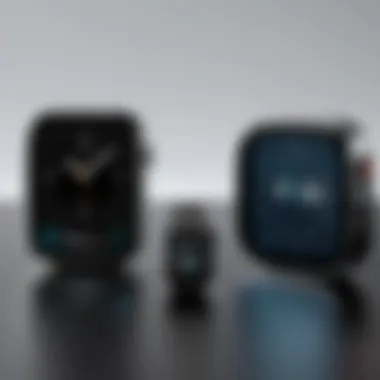Innovative Alarm Clock Apps to Kickstart Your Day


Intro
In today's fast-paced world, waking up can be a challenge for many individuals. Alarm clock apps are designed to combat this common problem, leveraging technology to help people rise at their desired times. This article examines various alarm clock applications, focusing on innovative features, user engagement strategies, and psychological principles that incentivize users to leave the comfort of their beds. As we explore the strengths and weaknesses of these applications, we aim to provide insights into their design and the technology that underlies them. Understanding the relationship between these tools and daily routines is crucial for optimizing productivity and well-being.
Key Features
Design and Build Quality
The design of alarm clock apps plays a significant role in user experience. A sleek and intuitive interface can make a substantial difference in user satisfaction. Many modern apps, such as Alarmy and Sleep Cycle, feature pleasing aesthetics and easy navigation, allowing users to set alarms quickly. High-quality visuals and well-organized layouts contribute to a more engaging experience.
In contrast, some applications may prioritize functionality over design. Typically, this approach results in a cluttered interface that may confuse users. Therefore, striking a balance between functionality and design is essential in creating a successful alarm clock app.
Display and Performance
Display quality impacts how effectively users interact with alarm clock apps. Responsive touch screens and clear fonts ensure that users can observe their settings at a glance. Some apps, like Timely, utilize dynamic backgrounds that change according to user preferences, enhancing engagement. Moreover, performance efficiency is crucial; an app that crashes or becomes unresponsive can hinder the user experience, creating frustration and impacting the likelihood of users waking up on time.
Psychological Principles in Alarm Clock Apps
Alarm clock apps leverage various psychological concepts to better encourage users to get out of bed. The principle of commitment plays a vital role, where users are more likely to respond to alarms when they have invested time in setting them.
Additionally, operant conditioning is utilized in apps like Alarmy, where users must complete specific tasks to disable the alarm, such as solving problems or taking photos of certain locations within their home. This engagement not only promotes wakefulness but also instills a sense of achievement, reinforcing the user's morning routine.
"Alarm clock apps are not merely tools; they represent an intersection of technology and behavioral psychology, aimed at enhancing user engagement and efficacy."
User Engagement Techniques
To improve user engagement, many alarm clock apps employ gamification. Alarmy, for example, turns waking up into a game, encouraging users to meet daily challenges to increase their motivation. Features like streaks or rewards for consistent wake-ups can create a sense of accomplishment that encourages long-term use.
Moreover, social elements are incorporated into some apps. Users can share their wake-up achievements or invite friends to join challenges. This camaraderie fosters a sense of community that can further enhance motivation.
End
The journey through examining alarm clock apps reveals not just their functionalities but also the intricate relationship between design, psychology, and user interaction. In a world where time is both a valuable asset and a persistent challenge, understanding how these apps work can lead to better daily habits and ultimately more satisfying lives.
Preface to Alarm Clock Apps
In today's fast-paced world, the ability to wake up on time is crucial. Alarm clock apps have emerged as essential tools for organizing our mornings and managing daily routines. They offer a range of features tailored to individual needs. Understanding these applications can greatly enhance one's waking experience and efficiency.
Purpose of Alarm Clock Apps
Alarm clock apps serve multiple purposes that go beyond just ringing at a set time. They assist users in establishing a healthy sleep schedule. By analyzing sleep patterns, these apps can recommend optimal times to wake up. Moreover, they combat common oversleeping issues. Some apps integrate motivational elements, which can encourage users to get out of bed promptly. This is particularly beneficial in a society where mornings can often feel overwhelming or chaotic.
Evolution of Alarm Technologies
The evolution of alarm clock technology has been notable. Traditional mechanical clocks have given way to digital solutions that offer advanced functionalities. Earlier, alarms simply beeped at a predefined time, but this has changed significantly.
Modern alarm clock apps can adjust based on user behaviors. For instance, some monitors sleep cycles and wake the user during light sleep, enhancing the overall experience. Others come with personalized settings, allowing individuals to select sounds, snooze durations, and other customizable features. As technology progresses, the merging of alarm clocks with smart home integrations offers even more possibilities, making waking up a more seamless part of daily life.
Key Features of Alarm Clock Apps
The field of alarm clock applications has undergone significant transformation, becoming more sophisticated and user-responsive. Practical features are critical in ensuring not just the ability to wake users but also to engage them effectively. This discussion will delve into specific elements of alarm clock apps, including customizable alarm tones, snooze functions, and gradual volume increase. Each of these features contributes to the overall purpose of the application: to motivate users to get out of bed timely and with minimal struggle.
Customizable Alarm Tones
One of the most essential features of any alarm clock app is the option to customize alarm tones. Choosing a sound that resonates with the user can dramatically affect waking experiences. Studies show that personalized sounds, whether they be calming tunes or energizing jingles, create a more pleasant waking atmosphere. Many users report that familiar sounds help ease the transition from sleep to wakefulness.
Additionally, apps often allow users to upload their own audio files or choose from a diverse library. This personalization enables users to engage more emotionally with their waking process. The possibility to choose specific tones for different days or events adds another layer of customization, appealing to users' varied preferences. A tailored selection fosters attachment and can act as a strong psychological motivator.
Snooze Functions
Snooze functions play a pivotal role in the alarm clock experience. They provide users with a brief extension of sleep, which can be comforting but may also lead to undesirable habits. Effective app designs redefine the snooze function, offering different strategies. Some apps limit the number of times users can hit snooze, nudging them towards more responsible waking habits.
Moreover, certain sophisticated applications utilize a delayed snooze feature. This means that the alarm will not just go off again after a set period but can also involve gentle sound progressions or reminders based on user-defined preferences. This strategy can aid users in avoiding disorientation during early waking hours and in improving the overall effectiveness of the alarm.


Gradual Volume Increase
The gradual volume increase feature is an innovative design element that enhances the waking process. Instead of a sudden, jarring noise, alarms that start quiet and increase in volume can provide a softer awakening experience. This method respects the body's natural sleep cycles and can lead to a more comfortable transition into wakefulness.
Apps employing this feature often allow users to determine the duration and intensity of the volume increase, customizing their waking experience. Users often find gradual sounds less stressful than abrupt alarms. The effectiveness of this method is supported by research indicating that gentle awakenings can improve mood and reduce waking anxiety.
In summary, the key features of alarm clock apps not only help individuals wake up effectively but also contribute to enhancing the overall experience. Customizable tones, strategic snooze functions, and gradual volume control collectively underline the potential of these applications to motivate users to exit sleep modes seamlessly. Higher customization and user engagement cultivate a more meaningful relationship with the app. As their design evolves, these features represent just a segment of what future alarm clock applications may offer.
User Engagement Mechanisms
User engagement is crucial for alarm clock apps. It defines how effectively these applications can motivate users to wake up on time and stick to their routines. Employing engagement mechanisms can lead to a sense of ownership and enhanced commitment among users. Without proper engagement, users might simply snooze alarms or ignore notifications. Here are the key elements of user engagement mechanisms.
Gamification Elements
Gamification in alarm clock applications serves to make waking up more enjoyable. By applying game-like features, these apps create an interactive experience. Users can earn points or rewards for waking up on time. This sense of achievement may encourage users to stick to their goals. Additionally, some apps offer levels of difficulty, providing a fun challenge that can keep users engaged.
- Progress Tracking: Many apps allow users to monitor their waking habits over time. This feature can motivate users to improve their waking-up skills.
- Leaderboards: Compare waking-up times with peers to foster a sense of friendly competition.
- Achievements: Unlocked achievements can serve as a visual reminder of one's commitment to better waking habits.
Challenges and Tasks
Adding challenges and tasks to alarm clock apps can enhance their effectiveness. Users often respond well to specific tasks they must complete to dismiss an alarm. This may include simple activities like solving a puzzle or completing a math problem. By making users engage cognitively, the likelihood of oversleeping decreases.
- Morning Tasks: Some apps require users to take pictures of predefined locations as proof of waking up. This adds an extra layer of motivation and accountability.
- Custom Challenges: Users can tailor their tasks based on personal preferences. Creating their unique morning rituals can solidify the habit of getting up on time.
Social Sharing Features
Social sharing is another vital feature for user engagement in alarm clock apps. By connecting with friends and family, users can share their achievements and experiences. This connection creates accountability and may lead users to feel more responsible about their waking habits.
- Social Media Integration: Users can post their successes on platforms like Facebook and Reddit. Sharing progress may encourage others to evaluate their waking habits too.
- Group Challenges: Users can join group challenges with friends. This collective effort can enhance motivation, as individuals don’t want to let their peers down.
"By implementing engagement features, alarm clock apps can greatly enhance user commitment and punctuality."
These mechanisms make it clear that simply setting an alarm is not enough. Users require motivation and support to change their behaviors. Alarm clock apps that effectively utilize user engagement can ultimately lead to positive lifestyle changes.
Psychological Principles at Play
Understanding the psychological principles behind alarm clock apps is essential to grasp how these tools effectively influence user behavior. By examining factors such as behavioral conditioning and motivation theory, we can uncover ways that these applications design experiences to facilitate waking up successfully. These principles directly tie to the efficiency of alarm apps, making them more than mere tools for setting alarms; they become systems for behavioral change.
Behavioral Conditioning
Behavioral conditioning plays a significant role in how users interact with alarm clock applications. This principle highlights the link between stimuli and responses. Alarm apps use various stimuli to create positive or negative associations with waking up. For instance, an alarm app might employ a pleasant sound as a waking stimulus, gradually increasing the volume to ensure the user eventually gets out of bed.
Moreover, actions taken by users after they wake up can reinforce behaviors. If a user consistently snoozes their alarm, the app may adapt by introducing harsher wake-up methods, such as requiring the user to complete a math problem or take a picture of a specific object. These methods leverage consequence-based learning, which is central to behavioral conditioning. The key advantage is that over time, users often learn to react positively to the sound of their alarm and associate it with necessary actions they must take to start their day.
Motivation Theory
Motivation theory provides insights into what drives individuals to engage with alarm clock apps beyond their primary function. It poses a critical question: What motivates a person to wake up and remain active throughout the day? Alarm clock apps address this by incorporating elements that can inspire and engage users.
For example, some applications use gamification techniques, rewarding users for consistent wake-up times. These rewards can be in the form of points or achievements that users can display or redeem. By integrating motivational elements, these apps promote not just the act of waking up but also the formation of positive habits over time.
Additionally, creating a sense of community can bolster motivation. Features that encourage social sharing of achievements or challenges create an environment where users feel supported, thereby enhancing commitment to their goals.
Understanding these psychological aspects deeply influences alarm clock app design. The blend of behavioral conditioning and motivation theory contributes to their effectiveness, helping users to not only wake up on time but also develop more productive daily routines.
Popular Alarm Clock Apps
In today's fast-paced world, the role of alarm clock apps is not just about waking users up; it extends to shaping daily routines and enhancing productivity. These applications serve as essential tools, especially for individuals who struggle with rising on time or those who prioritize maximizing their morning hours. Their designed features address common challenges associated with traditional alarms, such as repetitive snoozing and disconnection from sleep cycles.
Alarm clock apps incorporate various technologies and user engagement features to foster better waking habits. With the integration of smartphones into daily life, users seek applications that not only sound alarms but also offer personalized experiences that contribute to an effective start each day.
Choosing the right alarm clock app can significantly affect how easily a person rises from sleep. Factors to consider include the app's interface, customization options, and its ability to integrate with other tech solutions. Each app has unique strengths and weaknesses, which make evaluating them crucial for users hoping to improve their wake-up experience.
Overview of Leading Apps
Several alarm clock apps have gained popularity due to their unique functionalities and user-centric design. Notable examples include:


- Sleep Cycle: This app analyzes sleep patterns and wakes users in light sleep, promoting a more refreshed start to the day.
- Alarmy (Sleep If U Can): Users must complete tasks or challenges to turn off the alarm, making it effective for heavy sleepers.
- I Can't Wake Up!: This app includes various wake-up tasks, such as solving math problems or shaking the device to ensure users are alert.
These apps stand out not just because of their functionalities but also due to their ability to adapt to different user preferences. By examining these leading applications, one can appreciate how their ingenious designs cater to the need for effective wake-up solutions.
Comparison of Features
Comparing alarm clock apps involves looking closely at their individual capabilities and user benefits. Here are some essential features to consider in alarm clock apps:
- Customization: Different platforms offer specific alarm tones, themes, and user interfaces, which impact user experience.
- Snooze Options: Apps vary in how they handle snooze functionality, with some providing limits on snoozes or offering engaging alternatives.
- Sleep Analysis: Some apps provide insights into sleep cycles, helping users understand their rest patterns more effectively.
- Multi-Alarm Functionality: Features allowing multiple alarms can benefit users with differing schedules on a given day.
- User Interface Design: A seamless, intuitive interface enhances usability and minimizes frustration in those early morning moments.
Understanding these differences is vital for users looking to select the app that best suits their lifestyle needs and sleeping patterns. This comparison not only informs choices but also elevates awareness regarding how effectively an app can transform waking up into a more pleasant experience.
"A good alarm clock app does more than beep; it rethinks how we relate to sleep."
By incorporating technologies that resonate with user expectations, alarm clock apps have established a valuable niche in enhancing everyday life.
Effectiveness of Alarm Clock Apps
The effectiveness of alarm clock apps is a central theme in this article. In an age where technology intertwines with every part of our lives, the role of these apps cannot be overlooked. They serve an essential function beyond merely sounding an alert at a specified time. Their success hinges on various factors, including user engagement, psychological elements, and the technology they employ.
When discussing effectiveness, one must assess the specific elements and features that contribute to a user's ability to rise in the morning. This includes the customization options a user has in setting their alarms. Alarm clock apps are no longer one-size-fits-all; they understand the diverse needs of different users. The ability to choose unique alarm tones, adjust volume levels, or even incorporate gradual sound increases can greatly influence a user's waking experience.
Furthermore, understanding the benefits derived from using these apps is crucial. For many, the struggle to wake up on time is a daily battle. Alarm clock apps aim to alleviate this challenge by incorporating user-friendly interfaces and advanced functions.
Considerations about the effectiveness of these apps extend into personal routines. Users report varied experiences, so feedback mechanisms play a critical role. Analyzing user feedback helps developers recognize patterns of effectiveness, influencing future versions of the apps.
User Feedback and Reviews
User feedback and reviews are vital in determining the effectiveness of alarm clock apps. Many apps have integrated review systems that allow users to share their experiences. This feedback is often real-time and provides invaluable insights into what works and what doesn't.
- Immediate Response: Users often post reviews shortly after trying an alarm clock app, offering fresh perspectives on its features.
- User Base: With millions of downloads, apps like Alarmy or Sleep Cycle generate extensive reviews. This data can highlight not just the success in waking users but also dissatisfaction where applicable.
- Comparison Over Time: User reviews over time show trends in how updates or changes in functionality impact effectiveness.
Using platforms like Reddit or Facebook, users exchange experiences, and the discussion often leads to suggests on improving their waking routines. Positive feedback can enhance an app’s reputation, leading to higher downloads, while negative feedback prompts developers to initiate improvements.
Success Rates of Waking Users
The success rates of waking users significantly contribute to evaluating the effectiveness of alarm clock apps. Data collection methods vary, but many apps maintain metrics on how often users turn off alarms or report waking successfully.
- Statistical Analysis: Some apps use in-app gathering to analyze data, providing insights into their performance. For instance, apps like Alarmy may track how many users actually wake up when the alarm rings.
- Personal Reports: Users often find it beneficial to rate their wakefulness after using these apps. This self-reporting adds a subjective measure to success rates, complementing app-driven statistics.
- Longitudinal Studies: Some developers conduct studies over extended periods to establish how effective their app is in changing waking habits.
Overall, the collective data from user feedback and success rates paints a detailed picture of alarm clock apps' effectiveness. Ensuring users wake up on time isn’t just about sounding an alarm; it’s about designing a thoughtful, user-centric experience that motivates and engages. For anyone interested in maximizing morning productivity, these insights will be crucial.
Alarm Clocks and Sleep Patterns
Alarm clocks are not just tools for waking up. They play a significant role in understanding and managing sleep patterns. This section delves into the relationship between alarm clocks and our sleep cycles. It is important to recognize how alarm clock apps can influence sleep quality and morning alertness. Knowing how these elements intertwine is vital for optimal wake-up strategies.
Understanding Sleep Stages
Sleep occurs in several stages, primarily classified into two categories: non-REM and REM sleep. Non-REM sleep consists of three stages, each playing a crucial role in physical and mental restoration. The first stage is light sleep, where a person can be easily awakened. The second stage is a deeper sleep, and the third stage is the deepest, often described as slow-wave sleep.
REM sleep follows these stages and is when most dreaming occurs. A complete sleep cycle lasts about 90 minutes, repeating multiple times during a typical night. The timing of your alarm clock matters; waking up during deep sleep can lead to grogginess, whereas waking up during light sleep typically results in a more refreshing experience.
Impact of Alarm Sounds on Sleep
The sounds produced by alarm clocks can significantly affect the transition from sleep to wakefulness. Different types of sounds trigger varied responses in the brain. Soft, gradual tones may ease users out of sleep gently, while loud, harsh sounds can induce a sudden shock, potentially disrupting a waking process.
A study suggests that gradual sounds can lead to a better waking experience. On the contrary, alarming sounds might cause stress and lead to negative feelings toward mornings. Choosing the right sound in an alarm clock app has the potential to influence how awake and refreshed one feels.
"The choice of sound is not trivial; it engages the mind in how we perceive the morning and prepares us for the day ahead."
Trends in Alarm Clock App Design
In the fast-evolving digital landscape, alarm clock apps are experiencing innovations that significantly influence their design and functionality. The trend towards enhanced usability and integration with modern technologies reflects a broader shift in how individuals manage their time and daily routines. These designs cater not just to the practical need for waking up but also to the preferences and lifestyles of tech-savvy users.


One of the most significant trends is the integration with smart home devices. As smart homes gain popularity, alarm clock apps are adapting to this environment. Users can connect their alarm applications with devices like the Philips Hue smart lights or smart speakers such as Amazon Echo. This integration allows for an automated morning routine where the lights gradually brighten as the alarm goes off or the coffee pot starts brewing. This seamless transition from sleep to wakefulness presents a practical and comfortable solution to getting out of bed. The benefits extend to energy efficiency and enhanced ambiance, making mornings less jarring and more pleasant.
The second trend, advanced personalization techniques, is also gaining traction. Users now seek a tailored alarm experience that caters to their personal preferences. Apps are employing machine learning algorithms to analyze sleep patterns, there by suggesting optimal wake-up times based on individual habits. Additionally, features such as customizable sounds and themes allow users to create a unique experience. Some apps even offer options that allow modifying sounds based on the user's mood or time of day. This level of personalization not only enhances user satisfaction but can also improve the effectiveness of the alarms.
Reflecting on these trends, it is clear that alarm clock apps are no longer just tools for waking up. Instead, they have evolved into comprehensive systems that integrate with broader lifestyles and routines. By staying ahead of these trends, developers can create more compelling user experiences, ensuring users not only wake up but do so in a manner that resonates with their daily lives.
"The modern alarm clock app should engage users holistically, supporting not just their waking needs but also their lifestyle choices."
Challenges in the Use of Alarm Clock Apps
In the evolving landscape of alarm clock applications, understanding the inherent challenges is crucial. While these tools offer practical solutions for waking individuals, they also raise concerns that may undermine their effectiveness. Some of the key challenges include overreliance on technology and user fatigue due to alarm clutter. These issues warrant a closer examination to ensure that users can harness the full potential of alarm clock apps without falling into traps that diminish their wake-up experience.
Overreliance on Technology
The reliance on alarm clock apps has increased dramatically. Users often expect these applications to effectively manage their waking routines, sometimes neglecting personal discipline or natural body rhythms. This overreliance creates a dependency that can be problematic. One risk is the decreased ability to wake up without technological assistance. As people become accustomed to the convenience of their smartphones, they may forgo traditional methods of establishing a wake-up routine, such as setting consistent sleep schedules.
Moreover, when technology fails, it can lead to serious consequences. Alarm clock apps might crash or malfunction, resulting in missed wake-up calls. This potential for malfunction leads some individuals to distrust these applications, further complicating their sleep management. Thus, recognizing the limits of technology is vital for a sustainable approach to waking up on time.
User Fatigue and Alarm Clutter
Another significant challenge is user fatigue from having multiple alarms set. Alarm clutter arises when users create numerous alarms to ensure they wake up. This practice can complicate the waking process and cause confusion. Instead of making the morning routine smoother, packing various alarms can lead to anxiety about forgetting waking up. In some cases, users may find themselves sleeping through the chaos of overlapping notifications.
This phenomenon can be detrimental, as it undermines the original purpose of the alarm clock applications—to serve as efficient tools to wake users up from their slumber. To combat alarm clutter, users must prioritize quality over quantity. A more effective approach might involve selecting one or two reliable alarms rather than numerous backup alarms.
As a result, the design of future alarm clock apps should consider these challenges. By providing intuitive features and encouraging users to develop healthy waking habits, it may be possible to reduce reliance on technology and minimize alarm clutter, leading to a more productive start to the day.
Future Directions for Alarm Clock Technologies
The future of alarm clock technologies is important not just for users who want to wake up on time, but also for the broader context of daily routines and health. Technology continues to evolve, pushing the boundaries of what alarm clock apps can do. These advancements promise to enhance user experience and address common waking challenges. As we look into the future, two key areas present exciting possibilities: AI integration and health monitoring capabilities.
AI Integration and Predictive Features
Artificial intelligence has the potential to revolutionize alarm clock apps by tailoring them to individual user behaviors. By analyzing waking patterns over time, AI can predict optimal wake-up times based on sleep cycles.
For example, apps like Sleep Cycle are already using algorithms to assess not only how long users sleep but also the quality of that sleep based on movements detected during the night. Implementing machine learning in alarm clocks means they could, for instance, learn that a user typically wakes up more refreshed when disturbed during lighter sleep stages. Incorporating features like smart suggestions and reminders tailored to the user's lifestyle can help ensure timely wake-ups while mitigating grogginess.
Here are some benefits to consider with AI advancements:
- Personalization: More accurate wake-up times tailored to the individual.
- Adaptability: Alarm apps that adjust settings based on external factors, such as upcoming work schedules or weather changes.
- User Insights: Feedback mechanisms can provide users with data about their sleep trends and habits.
Health Monitoring Capabilities
Health is a critical aspect of waking successfully. Alarm clock apps may evolve to incorporate health monitoring features that track not only sleep quality but also general well-being. For instance, the integration of wearable devices like Fitbit or Apple Watch can supply valuable data to these apps. This information can be used to tailor wake-up strategies that promote both physical and mental health.
Some potential health monitoring capabilities include:
- Sleep Cycle Analysis: More in-depth tracking of REM and non-REM sleep cycles to wake users at optimal times.
- Stress Monitoring: Apps could analyze heart rate variability or other stress indicators during sleep to decide how gently to awaken users.
- Integration with Health Apps: Features that communicate with diet or fitness monitoring apps, offering wake-up prompts based on holistic health objectives.
"As alarm clock technologies continue to evolve, they may play a crucial role in promoting healthier sleep habits and improving overall user wellness."
The future points toward alarm clock apps becoming more than just tools for waking up. They could evolve into multi-functional devices that assist users in leading healthier lives. This evolution demands careful consideration of privacy, data security, and user preferences as we embrace these innovative technologies.
End
In this article, the examination of alarm clock apps highlights their pivotal role in daily routines. Alarm clock apps are no longer simple devices that beeps at a specified time. They now incorporate a variety of features designed to ensure that users wake up on time. The significance of this topic lies in understanding how these applications can improve morning habits, thus impacting overall productivity.
Summarizing Key Insights
A few crucial insights emerged from our exploration of alarm clock apps:
- User-Centric Design: The design of these apps focuses on user needs. Features like customizable tones and gradual volume increases cater to personal preferences.
- Engagement Mechanisms: Gamification aspects and tasks motivate users to engage rather than dismiss alarms without consequence. This approach helps foster better waking habits.
- Psychological Framework: Understanding behavioral conditioning and motivation theory gives insight into why some apps are more effective than others.
Overall, alarm clock apps are sophisticated tools that integrate technology into daily life, compelling users to rise from sleep with methodical efficiency.
Implications for Daily Routines
The implications of utilizing alarm clock apps extend beyond just waking up. They encourage a structured start to the day. Proper use of these applications can lead to improved time management and increased productivity.
- Behavioral Changes: Regular use of effective alarm clock apps can gradually shift user behavior towards healthier sleep patterns. This leads to substantial improvements in overall well-being.
- Technology Integration: As these apps evolve, their synergy with smart home devices enhances daily routines further. Users can create a seamless waking experience by linking alarm functions with other smart technologies.
The conclusion reinforces the idea that choosing a suitable alarm clock app can facilitate better mornings and, by extension, better days.



